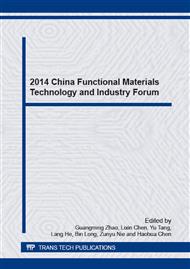p.31
p.39
p.43
p.53
p.59
p.67
p.74
p.78
p.82
Synthesis and Characterization of Poly(2-acrylamido-2-methyl propyl sulfonic acid-co-2-hydroxyethyl methclate)/ Silver Nanoparticle Composite Hydrogel as Catalysts for the Reduction of 4-Nitrophenol
Abstract:
A novel kind of AgNPs catalyst was synthesized by in-situ reduction method using poly(2-acrylamido-2-methyl propyl sulfonic acid-co-2-hydroxyethyl methclate) [short as P(AMPS-co-HEMA)] hydrogel as matrices and AgNO3 as a metal precursor. The structure of the composite hydrogel was characterized by Scan Electrical Microscope (SEM) and Fourier Transform Infrared Spectroscopy (FTIR). The results showed that AgNPs were binded with end group and most of the particles were isolated and uniformly distributed on the P(AMPS-co-HEMA). The catalytic properties in the reduction reaction of 4-nitrophenol(shorted as 4-NP) to 4-aminophenol(shorted as 4-AP) were studied in detail, and the result showed that conversion rate and conversion efficiency attained 97.56% and 0.9671 mmol/g·min when the amount of AgNPs was 9mg, [NaBH4] was 2.0×10−1 mol/L, [4-NP] was 2.0×10−2 mol/L and the total volume of solution was 50 mL, respectively.
Info:
Periodical:
Pages:
59-66
Citation:
Online since:
December 2014
Authors:
Price:
Сopyright:
© 2015 Trans Tech Publications Ltd. All Rights Reserved
Share:
Citation:


